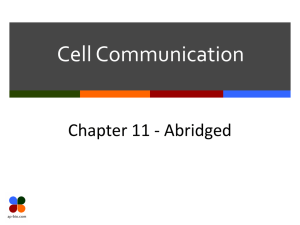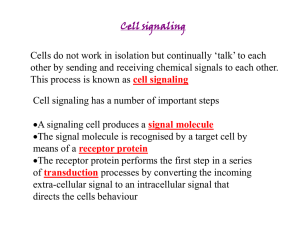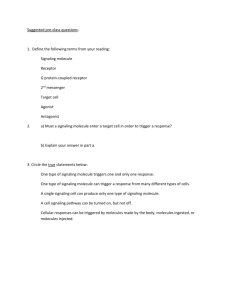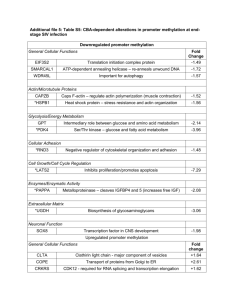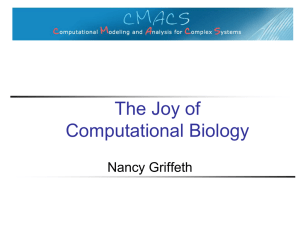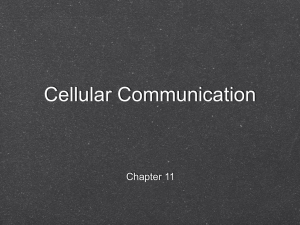AP Biology - Revere Local Schools
advertisement
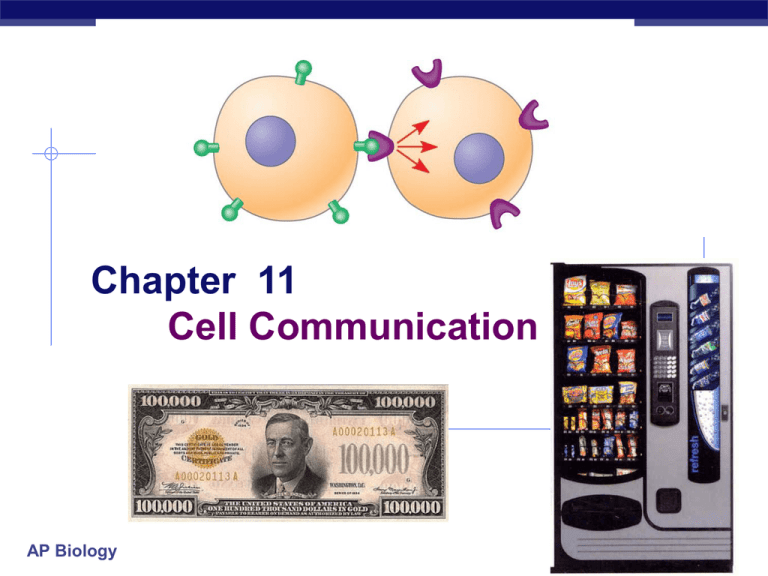
Chapter 11 Cell Communication AP Biology Cell-Cell Communication Animal cells use gap junctions to send signals Cells must be in direct contact Protein channels connecting two adjoining cells Gap junctions between animal cells AP Biology Cell-Cell Communication Plant cells use plasmodesmata to send signals Cells must be in direct contact Gaps in the cell wall connecting the two adjoining cells together Plasmodesmata between plant cells AP Biology Local Signaling Other types of signaling over a short distance Cell-cell recognition Membrane bound cell surface molecules Glycoproteins Glyolipids Local regulators Growth factors Only work over a short distance AP Biology Long-Distance Signaling Nervous System in Animals Electrical signals through neurons Endocrine System in Animals Uses hormones to transmit messages over long distances Plants also use hormones Some transported through vascular system Others are released into the air AP Biology Three Stages of Cell Signaling EXTRACELLULAR FLUID CYTOPLASM Plasma membrane 1 Reception Receptor The receptor and signaling molecules fit together (lock and key model, induced fit model, just like enzymes!) Signaling molecule Signaling molecule binds to the receptor protein AP Biology Three Stages of Cell Signaling CYTOPLASM EXTRACELLULAR FLUID Plasma membrane 1 Reception 2 Transduction Receptor 2nd Messenger! Relay molecules in a signal transduction pathway Signaling molecule The signal is converted into a form that can produce a cellular response AP Biology Three Stages of Cell Signaling CYTOPLASM EXTRACELLULAR FLUID Plasma membrane 1 Reception 2 Transduction 3 Response Receptor Activation of cellular response Relay molecules in a signal transduction pathway Signaling molecule Can be catalysis, activation of a gene, triggering apoptosis, almost anything! The transduced signal triggers a cellular response AP Biology G-Protein Receptors Plasma membrane G protein-coupled receptor Activated receptor Signaling molecule Enzyme GDP 2 1 CYTOPLASM G protein (inactive) GDP GTP Activated enzyme i GTP GDP P 4 3 Cellular response AP Biology Inactive enzyme Ion Channel Receptors Very important in 1 Gate closed Ions Signaling molecule (ligand) the nervous system Signal triggers the opening of an ion channel depolarization Triggered by neurotransmitters Ligand-gated ion channel receptor Plasma membrane 2 Gate open AP Biology Cellular response 3 Gate closed Fig. 11-9 Signaling molecule Receptor Transduction: Activated relay molecule Inactive protein kinase 1 A Phosphorylation Cascade Active protein kinase 1 Inactive protein kinase 2 ATP ADP Pi P Active protein kinase 2 PP Inactive protein kinase 3 Pi ATP ADP Active protein kinase 3 PP Inactive protein P ATP P ADP AP Biology Pi PP Active protein Cellular response Fig. 11-11 First messenger Adenylyl cyclase G protein G protein-coupled receptor GTP ATP cAMP Transduction in a G-protein pathway Second messenger Protein kinase A Cellular responses AP Biology Growth factor Receptor Response Reception Many possible outcomes This example shows a transcription response Phosphorylation cascade CYTOPLASM Inactive transcription factor Active transcription factor P DNA Gene NUCLEUS mRNA AP Biology Transduction Response Signaling molecule Specificity of the Receptor signal The same signal molecule can trigger different responses Many responses can come from one signal! Relay molecules Response 1 Response 2 Response 3 Cell A. Pathway leads Cell B. Pathway branches, to a single response. leading to two responses. AP Biology The signal can also trigger an activator or inhibitor The signal can also trigger multiple receptors and different responses Activation or inhibition Response 4 Response 5 Cell C. Cross-talk occurs Cell D. Different receptor between two pathways. leads to a different response. AP Biology Any Questions?? Can You Hear Me Now? AP Biology


